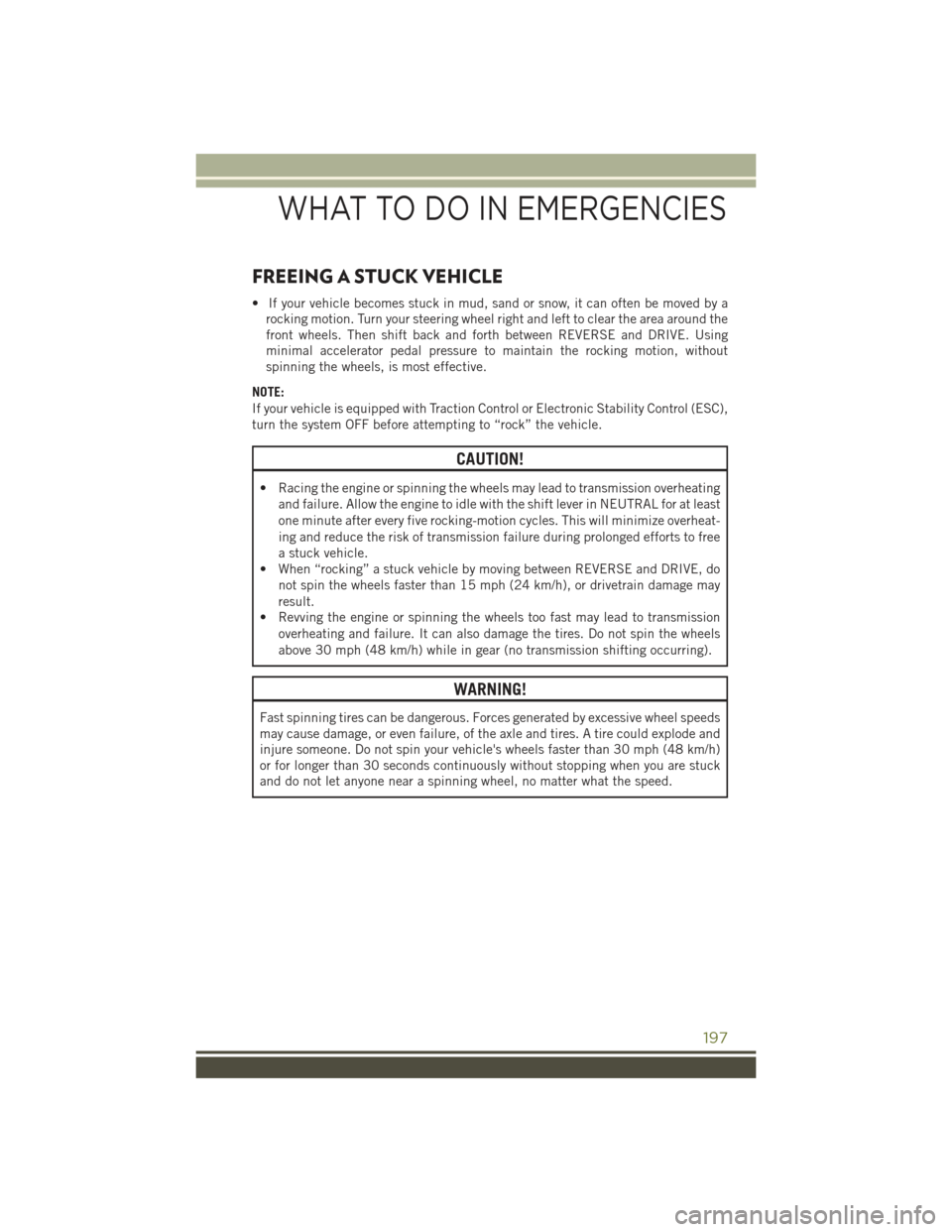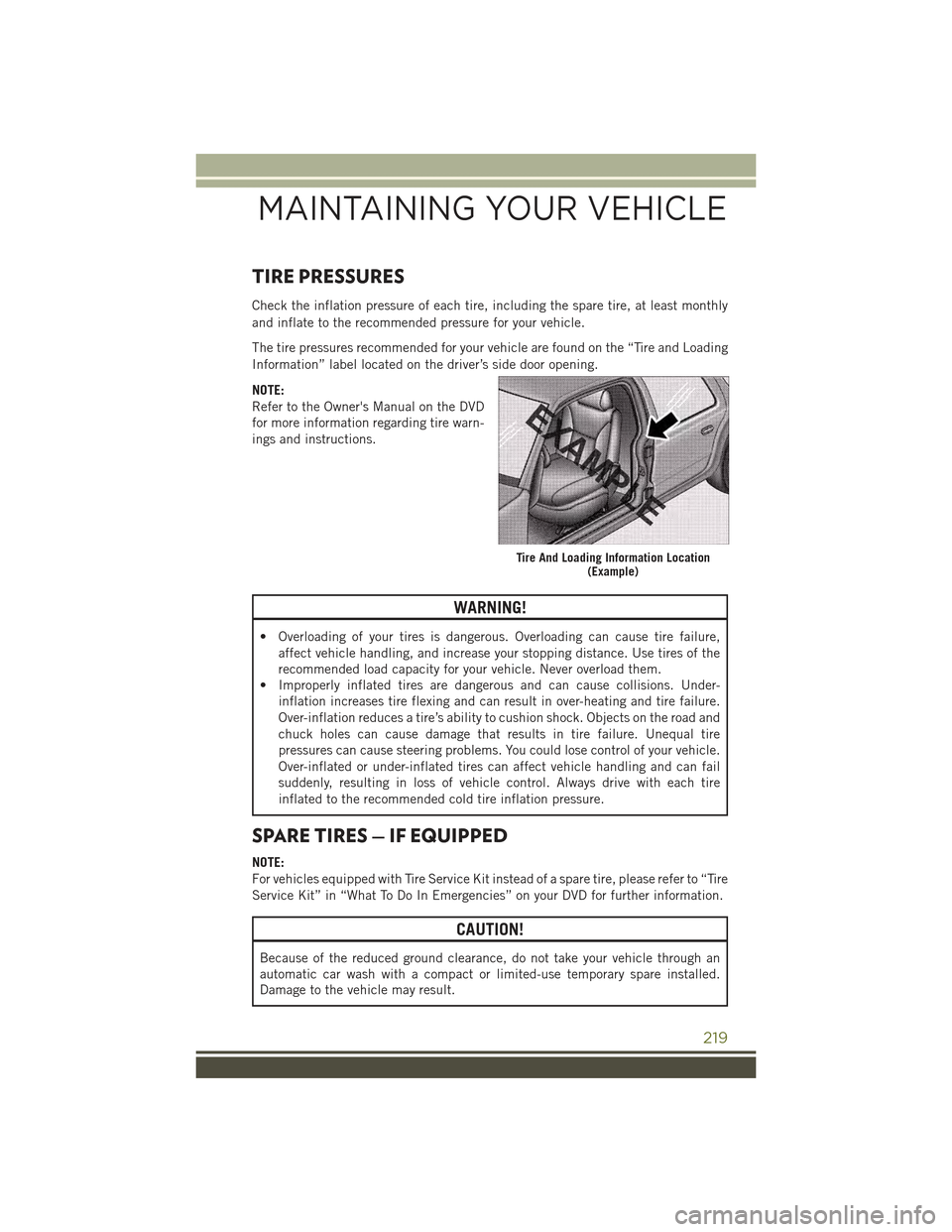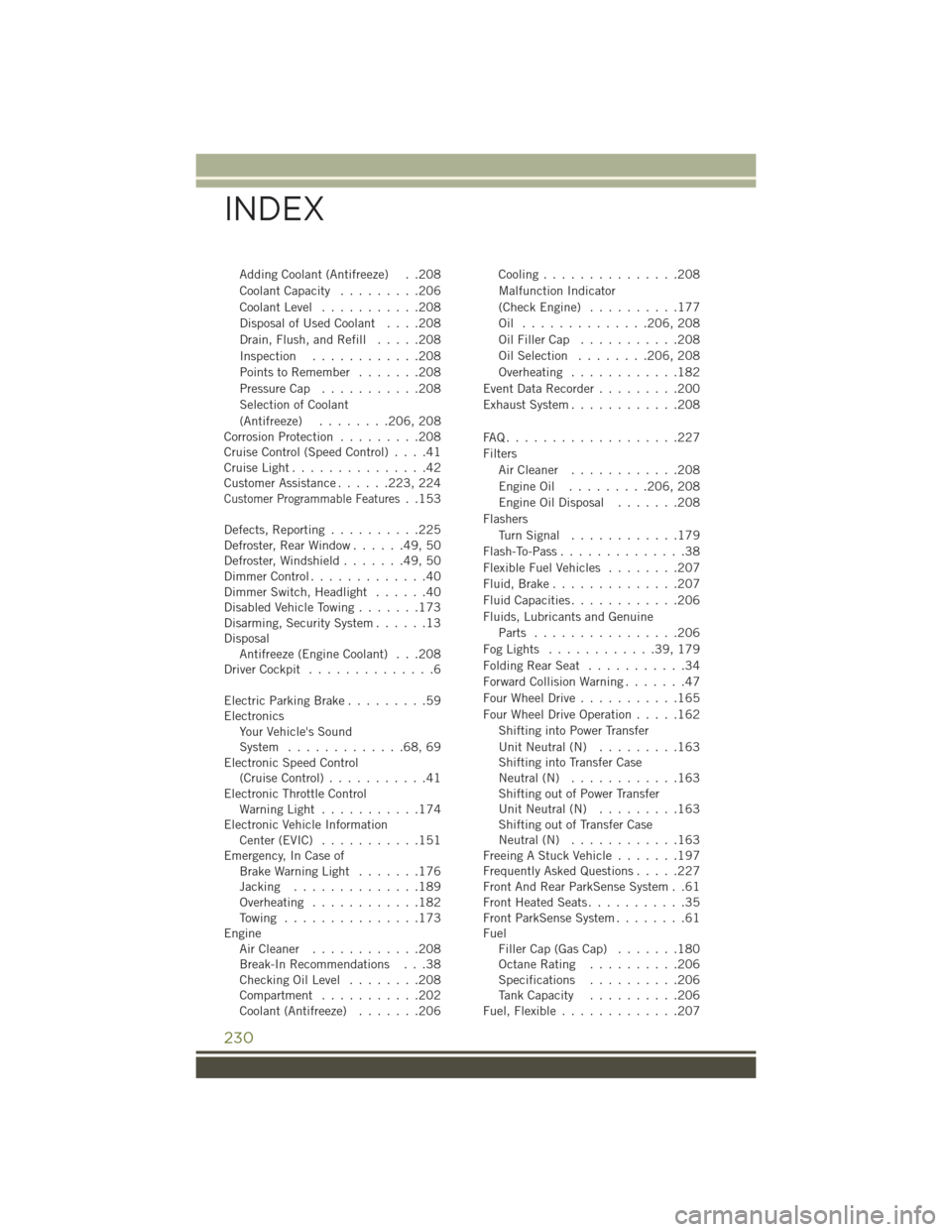heating JEEP CHEROKEE 2015 KL / 5.G User Guide
[x] Cancel search | Manufacturer: JEEP, Model Year: 2015, Model line: CHEROKEE, Model: JEEP CHEROKEE 2015 KL / 5.GPages: 244, PDF Size: 30.6 MB
Page 37 of 244

HEATED/VENTILATED SEATS
Front Heated Seats
The front heated seats control buttons are located within the climate or controls
screen of the touchscreen.
• Press the heated seat buttononce to turn the High setting On.
• Press the heated seat buttona second time to turn the Low setting On.
• Press the heated seat buttona third time to turn the heating elements Off.
If the High-level setting is selected, the system will automatically switch to Low-level
after approximately 60 minutes. The Low-level setting will turn Off automatically
after approximately 45 minutes.
NOTE:
Vehicle Equipped With Remote Start
On models that are equipped with remote start, this feature can be programmed to
come on during a remote start through the Uconnect®system. Refer to “Uconnect®
Settings” in “Understanding Your Instrument Panel” in the Owner's Manual on the
DVD.
WARNING!
• Persons who are unable to feel pain to the skin because of advanced age,
chronic illness, diabetes, spinal cord injury, medication, alcohol use, exhaus-
tion or other physical conditions must exercise care when using the seat heater.
It may cause burns even at low temperatures, especially if used for long periods
of time.
• Do not place anything on the seat that insulates against heat, such as a blanket
or cushion. This may cause the seat heater to overheat. Sitting in a seat that
has been overheated could cause serious burns due to the increased surface
temperature of the seat.
GETTING STARTED
35
Page 38 of 244

Front Ventilated Seats
Located in the seat cushion and seatback are small fans that draw the air from the
passenger compartment and pull air through fine perforations in the seat cover to
help keep the driver and front passenger cooler in higher ambient temperatures.
There are two ventilated seat control buttons located in the touchscreen that allow
the driver and passenger to operate the seats independently.
The ventilated seat buttons are used to control the speed of the fans located in the seat.
To operate the system, press the “Controls” button on touchscreen located on the
bottom of the Uconnect®display.
• Press the ventilated seat buttononce to choose HIGH.
• Press the ventilated seat buttona second time to choose LOW.
• Press the ventilated seat buttona third time to turn the ventilated seat OFF.
NOTE:
Vehicle Equipped With Remote Start
On models that are equipped with remote start, this feature can be programmed to come
on during a remote start through the Uconnect®system. Refer to “Uconnect®Settings”
in “Understanding Your Instrument Panel” in the Owner's Manual on the DVD.
HEATED STEERING WHEEL
The steering wheel contains a heating element that heats the steering wheel to one
temperature setting.
The heated steering wheel control button is located within the Uconnect®system.
You can gain access to the control buttons through the climate screen or the controls
screen.
• Press the heated steering wheel buttononce to turn the heating element ON.
• Press the heated steering wheel buttona second time to turn the heating
element OFF.
Once the heated steering wheel has been turned on, it will operate for up to
80 minutes before automatically shutting off. The heated steering wheel can shut off
early or may not turn on when the steering wheel is already warm.
NOTE:
Vehicle Equipped With Remote Start
On models that are equipped with remote start, this feature can be programmed to come
on during a remote start through the Uconnect®system. Refer to “Uconnect®Settings”
in “Understanding Your Instrument Panel” in the Owner's Manual on the DVD.
GETTING STARTED
36
Page 58 of 244

MAX A/C
• MAX A/C sets the control for maximum cooling performance.
• Press and release to toggle between MAX A/C and the prior settings. The button on
the touchscreen illuminates when MAX A/C is ON.
• In MAX A/C, the blower level and mode position can be adjusted to desired user
settings. Pressing other settings will cause the MAX A/C operation to switch to the
prior settings and the MAX A/C indicator will turn off.
Air Recirculation
• Push the Recirculation button for maximum A/C operation.
• To turn off Recirculation for window defogging, push the Recirculation button a
second time.
• If the Recirculation button is pushed while in the AUTO mode, the indicator light
shall illuminate. In cold weather, use of Recirculation mode may lead to excessive
window fogging. The recirculation feature may be unavailable (button greyed out)
if conditions exist that could create fogging on the inside of the windshield.
Heated Mirrors
The mirrors are heated to melt frost or ice. This feature is activated whenever you turn
on the rear window defroster.
Windshield Wiper De-icer — If Equipped
The windshield wiper de-icer is a heating element located at the base of the windshield.
The windshield wiper de-icer operates automatically once the following conditions
are met:
Activation By Front Defrost
• The wiper de-icer activates automatically during a cold weather manual start with
full defrost,theblower speed is greater than five,and when theambient temperature
is below 40° F (4.4° C).
Activation By Rear Defrost
• The wiper de-icer activates automatically when the Rear Defrost is operating and
theambient temperature is below 40° F (4.4° C).
Activation By Remote Start Operation
• When the Remote Start is activated and theoutside ambient temperature is less
than 40° F (4.4° C)the windshield wiper de-icer is activated. Upon exiting Remote
Start, the climate control functions will resume their previous operation except,
if the de-icer is active, the de-icer timer and operation will continue.
OPERATING YOUR VEHICLE
56
Page 184 of 244

• To turn the FCW system OFF, press the forward collision button once to turn the
system OFF (led turns on).
• For further information on Forward Collision Warning (FCW) operation and proper
use, refer to “Speed Control ” in “Operating Your Vehicle”.
- Liftgate Ajar Indicator — If Equipped
This indicator will illuminate when the liftgate is left ajar and not fully closed.
IF YOUR ENGINE OVERHEATS
In any of the following situations, you can reduce the potential for overheating by
taking the appropriate action:
• On the highways — slow down.
• In city traffic — while stopped, shift the transmission to NEUTRAL, but do not
increase engine idle speed.
NOTE:
There are steps that you can take to slow down an impending overheat condition:
• If your air conditioner (A/C) is on, turn it off. The A/C system adds heat to the
engine cooling system and turning the A/C off can help remove this heat.
• You can also turn the temperature control to maximum heat, the mode control to
floor and the blower control to high. This allows the heater core to act as a
supplement to the radiator and aids in removing heat from the engine cooling
system.
CAUTION!
Driving with a hot cooling system could damage your vehicle. If the temperature
gauge reads HOT (H), pull over and stop the vehicle. Idle the vehicle with the air
conditioner turned off until the pointer drops back into the normal range. If the
pointer remains on HOT (H), and you hear continuous chimes, turn the engine off
immediately, and call for service.
WARNING!
You or others can be badly burned by hot engine coolant (antifreeze) or steam from
your radiator. If you see or hear steam coming from under the hood, do not open
the hood until the radiator has had time to cool. Never try to open a cooling system
pressure cap when the radiator or coolant bottle is hot.
WHAT TO DO IN EMERGENCIES
182
Page 199 of 244

FREEING A STUCK VEHICLE
• If your vehicle becomes stuck in mud, sand or snow, it can often be moved by a
rocking motion. Turn your steering wheel right and left to clear the area around the
front wheels. Then shift back and forth between REVERSE and DRIVE. Using
minimal accelerator pedal pressure to maintain the rocking motion, without
spinning the wheels, is most effective.
NOTE:
If your vehicle is equipped with Traction Control or Electronic Stability Control (ESC),
turn the system OFF before attempting to “rock” the vehicle.
CAUTION!
• Racing the engine or spinning the wheels may lead to transmission overheating
and failure. Allow the engine to idle with the shift lever in NEUTRAL for at least
one minute after every five rocking-motion cycles. This will minimize overheat-
ing and reduce the risk of transmission failure during prolonged efforts to free
a stuck vehicle.
• When “rocking” a stuck vehicle by moving between REVERSE and DRIVE, do
not spin the wheels faster than 15 mph (24 km/h), or drivetrain damage may
result.
• Revving the engine or spinning the wheels too fast may lead to transmission
overheating and failure. It can also damage the tires. Do not spin the wheels
above 30 mph (48 km/h) while in gear (no transmission shifting occurring).
WARNING!
Fast spinning tires can be dangerous. Forces generated by excessive wheel speeds
may cause damage, or even failure, of the axle and tires. A tire could explode and
injure someone. Do not spin your vehicle's wheels faster than 30 mph (48 km/h)
or for longer than 30 seconds continuously without stopping when you are stuck
and do not let anyone near a spinning wheel, no matter what the speed.
WHAT TO DO IN EMERGENCIES
197
Page 221 of 244

TIRE PRESSURES
Check the inflation pressure of each tire, including the spare tire, at least monthly
and inflate to the recommended pressure for your vehicle.
The tire pressures recommended for your vehicle are found on the “Tire and Loading
Information” label located on the driver’s side door opening.
NOTE:
Refer to the Owner's Manual on the DVD
for more information regarding tire warn-
ings and instructions.
WARNING!
• Overloading of your tires is dangerous. Overloading can cause tire failure,
affect vehicle handling, and increase your stopping distance. Use tires of the
recommended load capacity for your vehicle. Never overload them.
• Improperly inflated tires are dangerous and can cause collisions. Under-
inflation increases tire flexing and can result in over-heating and tire failure.
Over-inflation reduces a tire’s ability to cushion shock. Objects on the road and
chuck holes can cause damage that results in tire failure. Unequal tire
pressures can cause steering problems. You could lose control of your vehicle.
Over-inflated or under-inflated tires can affect vehicle handling and can fail
suddenly, resulting in loss of vehicle control. Always drive with each tire
inflated to the recommended cold tire inflation pressure.
SPARE TIRES — IF EQUIPPED
NOTE:
For vehicles equipped with Tire Service Kit instead of a spare tire, please refer to “Tire
Service Kit” in “What To Do In Emergencies” on your DVD for further information.
CAUTION!
Because of the reduced ground clearance, do not take your vehicle through an
automatic car wash with a compact or limited-use temporary spare installed.
Damage to the vehicle may result.
Tire And Loading Information Location(Example)
MAINTAINING YOUR VEHICLE
219
Page 232 of 244

Adding Coolant (Antifreeze) . .208
Coolant Capacity.........206
Coolant Level...........208
Disposal of Used Coolant....208
Drain, Flush, and Refill.....208
Inspection............208
Points to Remember.......208
Pressure Cap...........208
Selection of Coolant
(Antifreeze)........206, 208Corrosion Protection.........208Cruise Control (Speed Control)....41Cruise Light . . . . . . . . . . . . . . .42Customer Assistance......223, 224
Customer Programmable Features..153
Defects, Reporting..........225Defroster, Rear Window......49,50Defroster, Windshield.......49,50Dimmer Control.............40Dimmer Switch, Headlight......40Disabled Vehicle Towing.......173Disarming, Security System......13DisposalAntifreeze (Engine Coolant) . . .208Driver Cockpit..............6
Electric Parking Brake.........59ElectronicsYo u r Ve h i c l e ' s S o u n dSystem.............68,69Electronic Speed Control(Cruise Control)...........41Electronic Throttle ControlWarning Light . . . . . . . . . . .174Electronic Vehicle InformationCenter (EVIC) . . . . . . . . . . .151Emergency, In Case ofBrake Warning Light.......176Jacking..............189Overheating............182To w i n g . . . . . . . . . . . . . . . 1 7 3EngineAir Cleaner . . . . . . . . . . . .208Break-In Recommendations . . .38Checking Oil Level........208Compartment...........202Coolant (Antifreeze).......206
Cooling...............208
Malfunction Indicator
(Check Engine) . . . . . . . . . .177
Oil . . . . . . . . . . . . . .206, 208
Oil Filler Cap...........208
Oil Selection........206, 208
Overheating............182
Event Data Recorder.........200
Exhaust System............208
FA Q . . . . . . . . . . . . . . . . . . . 2 2 7
Filters
Air Cleaner............208
Engine Oil . . . . . . . . .206, 208
Engine Oil Disposal.......208
Flashers
Tu r n S i g n a l . . . . . . . . . . . . 1 7 9
Flash-To-Pass..............38
Flexible Fuel Vehicles........207
Fluid, Brake..............207
Fluid Capacities............206
Fluids, Lubricants and Genuine
Parts................206
Fog Lights . . . . . . . . . . . .39, 179
Folding Rear Seat . . . . . . . . . . .34
Forward Collision Warning.......47
Four Wheel Drive...........165
Four Wheel Drive Operation.....162
Shifting into Power Transfer
Unit Neutral (N).........163Shifting into Transfer CaseNeutral (N)............163Shifting out of Power TransferUnit Neutral (N).........163Shifting out of Transfer CaseNeutral (N)............163Freeing A Stuck Vehicle.......197Frequently Asked Questions.....227Front And Rear ParkSense System . .61Front Heated Seats...........35Front ParkSense System........61FuelFiller Cap (Gas Cap).......180Octane Rating..........206Specifications..........206Tank Capacity..........206Fuel, Flexible.............207
INDEX
230
Page 234 of 244

Change Interval.........208Checking . . . . . . . . . . . . .208Disposal . . . . . . . . . . . . . .208Filter............206, 208Filter Disposal..........208Materials Added to........208Recommendation.....206, 208Viscosity..........206, 208Oil Filter, Selection..........208OutletPower . . . . . . . . . . . . . . .157Overheating, Engine.........182
Paint Care . . . . . . . . . . . . . . .208Panic Alarm...............12Parking Brake..............59ParkSense®...............61ParkSense®Active Park Assist....62ParkSense®System, Front And Rear..61ParkSense®System, Rear.......61Phone (Pairing).........113, 147Phone (Uconnect®). . . . . . . . . .147Placard, Tire and LoadingInformation.............219PowerGlass Sunroof...........64Inverter..............156Outlet (Auxiliary ElectricalOutlet) . . . . . . . . . . . . . .157Seats................31Programmable Electronic Features..153
Rain Sensitive Wiper System . . .40, 41Rear Camera . . . . . . . . . . . . . .63Rear Park Assist System........61Rear ParkSense System......61,63Rear Seat, Folding . . . . . . . . . . .34Recreational Towing . . . . . . . . .168Shifting into Power TransferUnit Neutral (N).........170Shifting into Transfer CaseNeutral (N)............170Shifting out of Power TransferUnit Neutral (N).........171Shifting out of Transfer CaseNeutral (N)............171Refrigerant...............208
Remote Keyless Entry (RKE)
Arm The Alarm...........13
Disarm The Alarm.........13
Remote Starting System........12
Replacement Bulbs..........222
Reporting Safety Defects.......225
Restraint, Head.............29
Roll Over Warning . . . . . . . . . . . .5
Schedule, Maintenance . . . . . . .208Seat Belt Maintenance . . . . . . . .208Seat Belts................17Adjustable Shoulder Belt.....17Pretensioners...........17Seats...................31Head Restraints..........29Heated...............35Rear Folding . . . . . . . . . . . .34Ventilated.............36Security Alarm............180Arm The System..........13Disarm The System........13Security Alarm...........13Selec-Terrain.............165Selection of Coolant (Antifreeze) . .206Set Up Your Via Mobile ProfileUconnect®.............73ShiftingPower Transfer Unit, Shifting intoPower Transfer UnitNeutral (N).........170, 171Transfer Case, Shifting intoTransfer Case Neutral (N)....170Transfer Case, Shifting out ofTransfer Case Neutral (N)....171Shift Lever Override.........198Signals, Turn...........38,179Sirius Satellite Radio.....104, 137SIRIUS Travel Link..........146Spare Tire . . . . . . . . .189, 220, 221Spark Plugs . . . . . . . . . . . . . .206SpecificationsFuel (Gasoline)..........206Oil . . . . . . . . . . . . . . . . .206Speed ControlAccel/Decel............42Distance Setting (ACC Only) . . .43Mode Setting (ACC Only).....45
INDEX
232